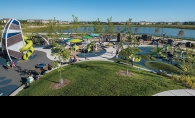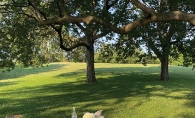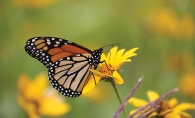An emerald ash borer recently came to town and realized how good we have it here in the Northwest quadrant of the Twin Cities. Soon he called his buddies to join him for a feast until the food was gone.
Ash borer are unwelcome guests with no intention of leaving. Their picnics are held along our streets and lanes on public property, but also on your private property. With Arbor Day around the corner (April 27), it’s a good time to take stock of what these clandestine, green, iridescent beetles have in mind for alterations in the view out your front—and back—window.
“Ash conservation efforts are stronger than ever, and treatment options are available to protect trees,” says Justin Bence of The Davey Tree Expert Company.
He suggests you start by identifying how many ash trees you have and check them for signs of emerald ash borer (EAB). It’s possible to catch the pest early through a simple inspection, so the tree can be saved. You can report any sighting of EAB yourself or have a free EAB consultation by a professional who can suggest available treatments.
“If your tree is a good candidate for preservation, and the treatment is applied at the right time in the right way by a certified applicator, the effectiveness of EAB treatment is 85 to 95 percent. Plus, treating the tree is a much less expensive option to replacing it with one of a similar size,” Bence assures.
A Plan to Replace
Make sure to diversify what you choose to plant in place of removed trees. This way, if one of the replacement species suffers a disease, your entire selection won’t be wiped out. Bence explains that this spring, hundreds of ash trees are being replaced. Selecting a suitable replacement tree helps neighborhoods recover quickly and avoid another EAB-like catastrophe.
“To grow a healthy tree, it’s all about planting the right tree in the right place. I see a lot of issues when people plant trees too close together or too close to the house,” Bence says.
Did You Know?
Last year, Maple Grove amended its EAB management plan to request that citizens report any sign of the pest to the city. It also requires that citizens have an arborist with an International Society of Arboriculture certification (or post-secondary degree in urban forestry, arboriculture or an equivalent area) care for their ash trees, whether it be for removal or treatment.
EAB clues
Infest ash trees (diamond-patterned bark and stand-alone leaves on each stem)
Chewed edges of leaves
D-shaped holes chewed through the bark
Split bark or S-shaped tunnels beneath the bark
Canopy dieback that typically begins in the top one-third of the canopy
Multiple sprouts of new growth
at the trunk
Increased woodpecker activity
The low-down from our expert on the tree you thought you wanted.
Toughest to raise in the Maple Grove climate: Colorado blue spruce, linden (wet springs lead to fungal disease, Japanese beetles eat its leaves).
Trees homeowners tend to regret planting: Crab apple, magnolia, linden, black hills spruce (apple scab, scales, Japanese beetles, fungal issues).
Hardy Option: The pagoda dogwood blooms with fragrant yellow or white flowers and keeps performing beyond spring, bearing fruit in late summer and boasting reddish-purple autumn foliage. Plus, it's a disease-resistant alternative to its popular cousin, the flowering dogwood.
The City of Maple Grove offers additional information on identifying ash trees and EAB at the website here.









